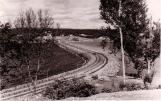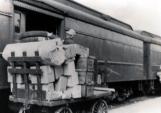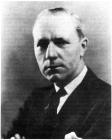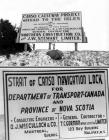31
BEGINNING OF TOURISM INDUSTRY - By 1927, the Nova Scotia government was trying to attract more visitors to Cape Breton Island. They published a fifty page promotional book with this colourful cover. This would be the beginning of having to address tourists' needs to cross the Strait of Canso in a safe and reliable manner in much larger numbers.During WWII, due to restrictions on gasoline and difficult conditions of motoring, the traffic of automobiles varied between 22,000 and 28,000 vehicles a year; in 1946, 51,166 vehicles crossed the Strait and in 1949 more than 90,000. (NS Dept. of Highways and Public Works 1949 Annual Report)
32
Line up of 154 cars on Granville Street back as far as Embree's Island waiting to get on car ferry.1954
Port Hawkesbury, Inverness County, Nova Scotia, Canada

33
BIRTH OF CAUSEWAY IDEA - No action may have taken place during the war years, but some people were well aware of the problems in crossing the Strait of Canso between Cape Breton Island and mainland Nova Scotia at Point Tupper and Mulgrave for the train ferries and Port Hawkesbury and Mulgrave for the car ferries.John R. MacIssac, the General Manager of Traffic and Transportation at Sydney's Dosco Steel Plant, fully appreciated the hazard on the Strait of Canso. He foresaw the threat of submarines along the coast and realized that several types of accidents or enemy actions could seriously impair or cripple Cape Breton's important contribution to the allied cause. He advocated and promoted a causeway in the general vicinity of Cape Porcupine that had tons of rock and Balhache Point (Port Hastings). His efforts did not bring the causeway but his contribution as a spokesman did much to popularize the type of crossing that later was built.
35
PERMANENT CROSSING WOULD MEAN JOB LOSS TO STRAIT AREA RESIDENTS - There wasn't any interest among the local people for a permanent crossing. There were too many who made their living on both sides of the Strait on the railroad and by transporting people and goods across the Strait.The 1951 census showed that the population of Cape Breton Island was 157,014. Sydney and the communities within an eighteen mile radius around it such as Glace Bay, New Waterford, Sydney Mines and North Sydney had a population of 83,000. The population of the larger communities in the Strait area was: Port Hawkesbury 1,034, Point Tupper 394 and Mulgrave 1,212 so the two hundred or more jobs to be lossed to the whole area would be devastating to residents of the Strait.
37
THE RIGHT MAN AT THE RIGHT TIME - Angus L. Macdonald was instrumental in getting a fixed link for the Strait of Canso area. He was the Premier of Nova Scotia from 1933 to 1940 and from 1945 to 1954. The five year period between was spent in Ottawa as a Minister of the war time cabinet. It was the determination of Angus L. combined with the resources of the Canso Crossing Association that saw the area's dream of a permanent crossing realized.L.J. Doucet, who served on the executive of the Canso Crossing Association, spoke of the leadership of Angus L. Macdonald and the role the Premier played in having the Causeway built in his book "Road to the Isle - The World's Deepest Causeway" published in 1955....
"It was during the period when the engineering opinion was consolidating itself behind a causeway that the late Honourable Angus L. Macdonald stood out as a man of diplomacy, resourcefulness and capacity. Without his fearless leadership and honesty and likewise without the Honourable Lionel Chevrier's desire to live up to his promises and committments, the Canso Project would still be an unattained dream..."
38
Strait of Canso filled with iceApril, 1950
Port Hawkesbury, Inverness County, Nova Scotia, Canada
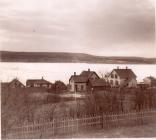
39
NO SENTEMENTAL JOURNEY: IT TOOK 23 HOURS - March 8, 1950 - The Cape Breton Post "A five-hour wait in Truro; five hours amid crunching ice floes in the Strait of Canso. Arrived at Sydney depot 23 hours after leaving Halifax.That was the log of the C.N.R. Express which arrived in Sydney from Halifax last night more than eight hours late. At 7 p.m. last night about 70 disgruntled passengers stepped off, looking forward to the day when the Canso Bridge would connect Cape Breton with the outside world, it has been thus for many years but yesterday's journey probably was one of the worst on record.
The train left Halifax at 9 p.m. Two hours later it arrived in Truro where it stood for five hours waiting for the Montreal carrier. But the payoff came at the Strait of Canso. The train arrived at the Strait shortly before dawn and then the shuffle started. The cars were transferred to the ferry which attempted a crossing. For two hours the craft bucked the heavy drift ice. The passengers became hungry and the ferry captain decided to turn back for Mulgrave. Here the travelers were taken to restaurants and private homes for a meal.
On the second trip, the ferry caught again and for three hours battled the ice which one railway official described as "the worst I have seen in many years."
The train reached Point Tupper at 3:30 p.m. and continued the journey to Sydney arriving shortly after 7 p.m. - 23 hours after leaving Halifax.
40
View of Strait of Canso in relation to Atlantic Canada showing its close proximity to Sable Island.22 August 2004
Atlantic Provinces and the Strait of Canso
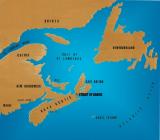
41
NEWFOUNDLAND JOINS CANADA - The Canso Causeway Association belaboured in their booklet published in December 1948 the significance of Newfoundland joining Canada in 1949 and raised the concern about the delays at the Strait of Canso.They also raised the increasing interest in 1949 on the country wide scale of the Trans Canada Highway being constructed and how it would cross the Strait of Canso. (Referring to the ferries) "Why not abolish such inadequate, uneconomic and sometimes dangerous obstructions? Wisdom suggests their replacement by a permanent crossing which should carry not only the Trans Canada Highway but also the tracks of the Canadian National Railways."(A Permanent Crossing over the Strait of Canso,Dec.23rd, 1948)
43
DREAM TO BECOME REALITY - In June of 1951, the Honourable Lionel Chevrier, Minister of Transport for the federal government, tabled a report in Ottawa which changed the recommendation of the Board of Engineers to go from a low level bridge to a causeway to join Cape Breton Island to Nova Scotia's mainland. The job of preparing the plans for the stone causeway and navigation locks was awarded to O.J. McCulloch Engineering Company of Montreal. In 1952, tenders were called and the 50 year dream of a fixed link from Cape Breton Island across the Strait of Canso to mainland Nova Scotia was official .Northern Construction and J.W. Stewart Limited began preparation at the Cape Porcupine construction site in Auld's Cove in July 1952.
44
Photo of Canso Causeway, taken from Cape Porcupine, looking towards Cape Breton Island.1955
Canso Causeway
